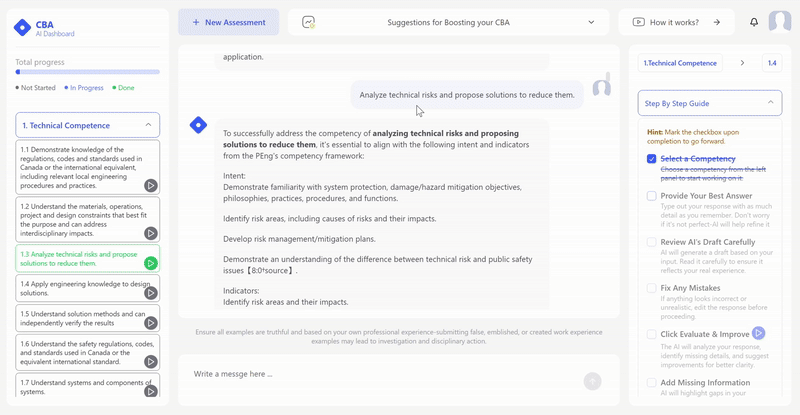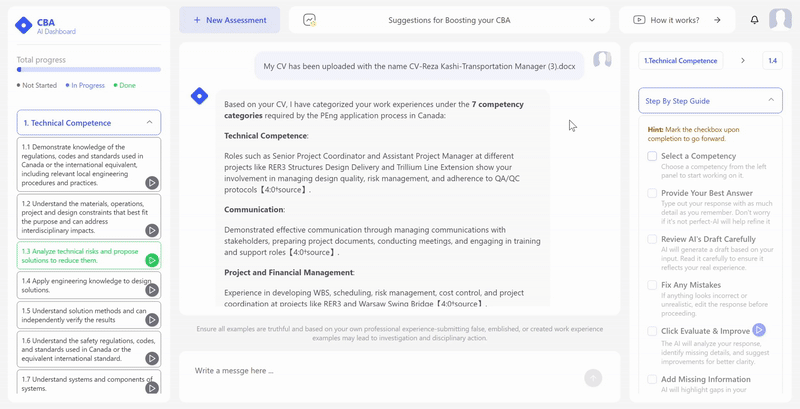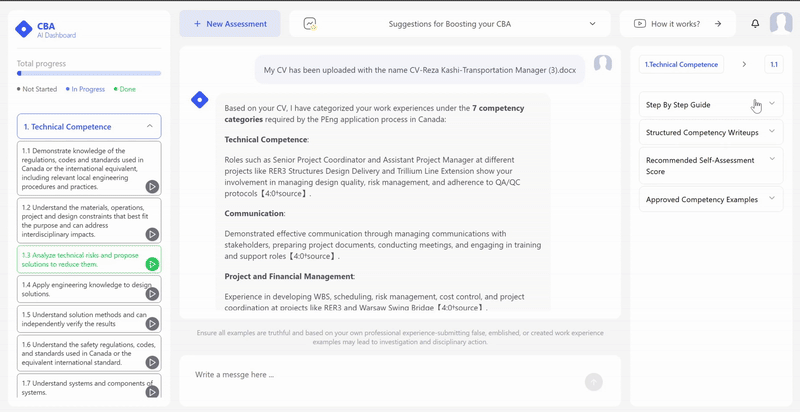For internationally trained engineers, transitioning into the Canadian engineering profession presents both exciting opportunities and significant challenges. One of the most critical steps in obtaining a Professional Engineer (P.Eng.) license in Canada is mastering the Competency-Based Assessment (CBA) system. Unlike traditional experience summaries, CBA requires applicants to demonstrate their engineering competence through specific examples aligned with 34 standardized competencies across seven categories. Understanding this framework is essential for navigating the licensing process with confidence.
In recent years, provincial regulatory bodies like Professional Engineers Ontario (PEO) and Engineers and Geoscientists BC (EGBC) have shifted toward CBA to create a transparent, equitable, and rigorous method for assessing engineering qualifications—particularly for applicants with diverse educational and professional backgrounds. For internationally trained professionals, adapting to this system means more than just translating their experience—it involves learning to articulate engineering work in a manner that aligns with Canadian standards, regulatory expectations, and public safety commitments.
Fortunately, support tools like CBA Pro are designed specifically for this transition. Whether you’re trying to match your international experience with the CBA competencies or looking for guidance on writing impactful examples, CBA Pro provides AI-assisted support, interactive templates, validator coordination, and personalized insights. It’s more than a writing tool—it’s a roadmap to licensure success tailored for international engineers.
Understanding the CBA Framework
For internationally trained engineers aiming to become licensed in Canada, understanding the Competency-Based Assessment (CBA) framework is a vital first step. The CBA system replaces the traditional narrative experience summary with a structured evaluation model that measures not just what you’ve done—but how well you can demonstrate your engineering competence in key professional areas. This system ensures all applicants, regardless of where they were trained, are assessed consistently and fairly.
The CBA is built around 22-34 core competencies (depending on your association), categorized into seven essential groups:
Professional Accountability
Social, Economic, Environmental, and Sustainability
Personal Continuing Professional Development
Each competency represents a skill or knowledge area that professional engineers must demonstrate to ensure they can practice safely and ethically in Canada. These range from applying engineering codes and standards (Competency 1.1), to demonstrating leadership in teams, to understanding the impact of engineering decisions on society and the environment.
For internationally trained engineers, adapting to CBA in Canada requires more than just listing tasks from past roles. You must align your experience with the Association-defined indicators for each competency, often using a Situation-Action-Outcome (SAO) format. This storytelling approach helps assessors evaluate your depth of knowledge, independent decision-making ability, and readiness for licensure.
Key distinctions of the Canadian CBA framework include:
Minimum ratings per competency: Most require a rating of 1 or higher, while professional standards competencies (e.g., ethics, safety) require 2 or 3.
Validator input: Each work example must be validated by a qualified professional who can confirm your role and competence.
Assessor review: Final evaluation is conducted by trained assessors from the regulatory body (e.g., PEO, EGBC, APEGA).
Navigating these requirements can be overwhelming, especially for those unfamiliar with Canadian engineering practices. That’s where CBA Pro becomes invaluable. This AI-powered platform simplifies the CBA process by helping internationally trained engineers match their experiences to the appropriate competencies, highlight transferable skills, and generate well-structured examples ready for submission.

Understanding the framework is the foundation for success. With the right tools and knowledge, international engineers can confidently bridge the gap between global experience and Canadian licensing standards.
Challenges Faced by Internationally Trained Engineers
The journey to licensure in Canada is filled with unique hurdles, especially for internationally trained engineers adapting to CBA in Canada. Despite years of valuable engineering experience abroad, many face unexpected obstacles when attempting to align their qualifications with Canada’s competency-based licensing framework. Understanding these challenges is the first step toward overcoming them.
Translating International Experience into Canadian Context
One of the most common challenges is translating international engineering experience into CBA language. Many applicants struggle to frame their work in a way that matches the competencies and indicators outlined by Canadian regulators such as PEO or APEGA. Even if the engineering work was technically sound, failure to demonstrate how it meets Canadian safety standards, codes, or professional obligations often results in low assessor ratings. This is one of the main concerns that CBA Pro solves for internationally trained engineers.

Limited Knowledge of Canadian Standards and Codes
Another key barrier is the lack of familiarity with Canadian engineering regulations and standards. For instance, Competency 1.1 requires engineers to demonstrate knowledge of Canadian or equivalent codes. International applicants may have followed standards such as Eurocode or ISO, but without contextualizing these against Canadian equivalents (CSA, CEC, etc.), they risk not meeting the minimum rating requirements.
Cultural and Communication Barriers
The CBA process demands concise, clear, and technically detailed examples, structured using the Situation-Action-Outcome format. This writing style is often unfamiliar to international engineers, especially those from cultures where communication tends to be more indirect or hierarchical. Furthermore, English (or French) may not be their first language, adding a language barrier to an already complex process.
Other common issues include:
Difficulty in identifying acceptable validators, especially for experience gained abroad
Misunderstanding the minimum rating requirements and average thresholds across competency categories
Uncertainty about what assessors are actually looking for in a “strong” work example
This is where many internationally trained engineers lose confidence—but it doesn’t have to be that way.
CBA Pro was built precisely to help international applicants navigate these obstacles. With guided templates, AI-powered example enhancement, and intelligent gap analysis, CBA Pro ensures your global engineering experience is translated clearly and effectively for Canadian assessors. It also supports language clarity and validator coordination—making the entire process less daunting and far more achievable.

Utilizing Available Resources
One of the most empowering steps for internationally trained engineers adapting to CBA in Canada is learning to leverage the wide range of resources designed to support their success. Whether it’s understanding Canadian standards, refining work examples, or connecting with mentors, the right tools can transform the licensing journey from confusing to achievable.
CBA Pro – Your Digital Companion Through the CBA Journey
CBA Pro is a purpose-built platform developed specifically for engineers navigating the Canadian Competency-Based Assessment process. Designed by CertNova Software Solutions, CBA Pro empowers users with:
AI-guided experience mapping: Match your international work history directly to the 34 required competencies.
Smart work example builder: Create strong Situation-Action-Outcome (SAO) narratives with real-time suggestions.
Competency gap analysis: Identify which areas need more evidence or stronger examples.
Validator coordination tools: Assign and track validator feedback efficiently across competencies.
Peer-reviewed templates: Gain insights from successful submissions and refine your approach.
For internationally trained engineers unfamiliar with how to present their work in the Canadian regulatory format, CBA Pro removes ambiguity and boosts confidence.
Engineering Regulatory Body Websites
Provincial regulators such as:
PEO – www.peo.on.ca
APEGS – www.apegs.ca
EGBC – www.egbc.ca
APEGA – www.apega.ca
Engineers Geoscientists Manitoba – www.enggeomb.ca
These websites offer guidelines, document templates, and specific instructions for completing the CBA process. These sites also host practice standards, ethics manuals, and information on validator expectations. Be sure to download the relevant competency framework and rating guide from your provincial association. You can also check out PEng Guide on our website for further materials.
Mentorship & Peer Networks
Joining a community of engineers who have gone through or are currently navigating the CBA process can be incredibly beneficial. Look for:
Local immigrant-serving organizations or professional bridging programs.
LinkedIn groups focused on Canadian engineering licensure.
Webinars and information sessions hosted by regulators or engineering societies.
Forums on competencybasedassessment.ca, where engineers share advice and support.
Learning from the experience of peers not only demystifies the process but also offers moral support during a complex and often isolating journey.
For internationally trained engineers adapting to CBA in Canada, the difference between success and frustration often lies in resourcefulness. With the structured support of CBA Pro and other trusted tools, you’re no longer navigating the system alone—you’re working with technology, community, and knowledge all aligned toward your success.
Conclusion
The path to becoming a licensed Professional Engineer in Canada may seem complex for those with international backgrounds, but it is absolutely achievable with the right understanding, mindset, and tools. The Competency-Based Assessment (CBA) system is designed to be inclusive, fair, and focused on real-world engineering capabilities—making it a powerful framework for showcasing your global experience in a Canadian context.
For internationally trained engineers adapting to CBA in Canada, the key to success lies in learning how to translate your past work into competency-aligned examples that reflect not only what you’ve done, but how you’ve done it in line with Canadian engineering values, standards, and safety obligations. From mastering the 34 competencies to coordinating validators and articulating complex projects clearly, each step is a chance to reinforce your readiness for professional practice.
You don’t have to navigate this process alone. CBA Pro is your partner in this journey—offering AI-powered guidance, customizable templates, and validation tracking to help you present your experience with confidence and clarity. It’s not just a tool—it’s a tailored solution for international engineers building a professional future in Canada.


